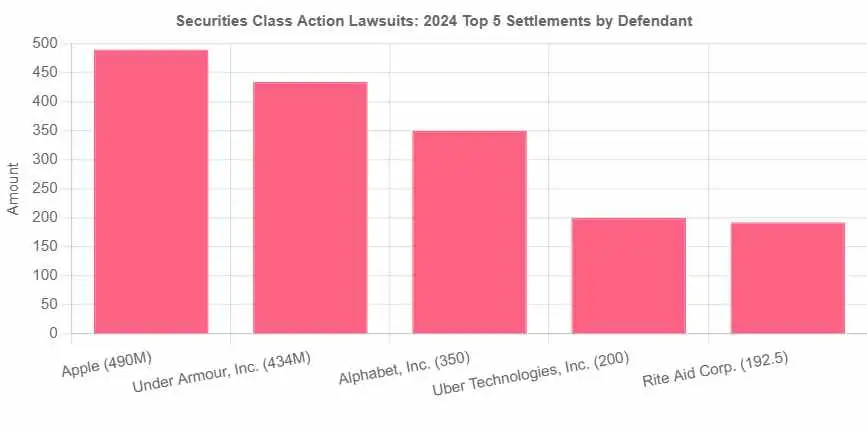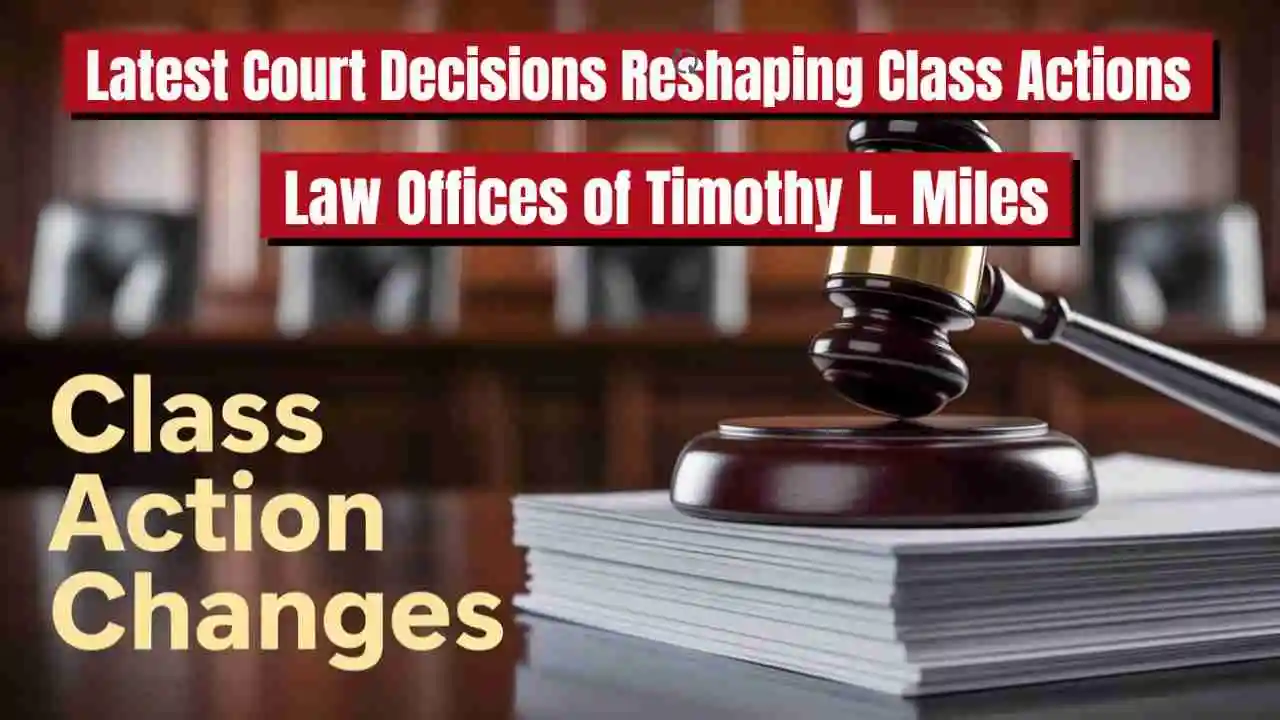Introduction to Securities Litigation in 2025

Securities litigation protects investors by making the financial world feel the impact of securities class actions with massive amounts at stake. U.S. corporate exposure to alleged violations of Rule 10b-5 of the Exchange Act hit $321.1 billion in 2019. These cases have created most important financial consequences for corporations and investors.
Historic settlements paint a clear picture of the scale of securities class actions. The largest settlements reached astronomical figures – Enron at $7.2 billion, WorldCom at $6.1 billion, and Tyco International at $3.2 billion. Public pension funds and labor union funds lead much of these fraud cases as plaintiffs. Their role is a vital part of securities class action lawsuits.
This comprehensive guide will get into how recent court decisions have altered the map of securities litigation through 2025. Legal standards keep evolving while precedent-setting cases shape the future. Global trends affect both corporations and investors in new ways. We wil give an explanation about corporate exposure estimates and risk management strategies to help navigate this complex legal landscape.
Key Legal Standards Governing Securities Class Actions
The legal system’s approach to securities class actions builds on several provisions that litigation and laws have shaped over many decades. These rules set boundaries for plaintiffs and defendants who get involved in securities litigation.
Section 10(b) and Rule 10b-5 of the Securities Exchange Act
Section 10(b) of the Securities Exchange Act and Rule 10b-5 are the foundations of securities fraud litigation. This rule prohibits anyone from using “any device, scheme, or artifice to defraud” or making material misstatements or omissions when buying or selling securities. Courts have recognized an implied private right of action under these provisions since the mid-1940s, though the statute doesn not explicitly state this.
Plaintiffs must prove six elements to establish liability under Section 10(b):
- A material misstatement or omission
- Scienter (intent to deceive, manipulate, or defraud)
- Connection between the misrepresentation and security purchase/sale
- Reliance on the misstatement or omission
- Economic loss
- Causal cconnection between the misrepresentation and the loss
The Supreme Court’s recent ruling in Macquarie Infrastructure Corp. v. Moab Partners LP made it clear that “pure omissions” alone can’t support private claims under Section 10(b) and Rule 10b-5, even when such omissions might violate SEC regulations. This decision has substantially limited potential securities fraud claims.
Class action plaintiffs face a particular challenge with the reliance requirement. Courts have developed the “fraud on the market” theory, which assumes efficient markets reflect all public, material information in security prices.
Section 11 of the Securities Act of 1933: Tracing and Standing
Section 11 focuses on misrepresentations in registration statements, while Section 10(b) deals with fraudulent practices more broadly. Issuers, underwriters, directors, officers, and experts who helped prepare the registration statement face strict liability for material misstatements or omissions under this provision.
The Supreme Court’s unanimous decision in Slack Technologies, LLC v. Pirani altered the map of Section 11 litigation in 2023. The Court ruled that plaintiffs must “plead and prove that he purchased shares traceable to the allegedly defective registration statement,” including direct listings where registered and unregistered shares are offered simultaneously. This ruling strengthened the “tracing” requirement that circuit courts had applied to traditional offerings.
This decision has real-world implications. Plaintiffs who buy securities in the open market might find it impossible to establish standing without tracing their shares to those registered in the offering documents. Companies that list unregistered shares alongside registered offerings now have less exposure to Section 11 claims.

Federal Rule of Civil Procedure 23 and Class Certification in Securities Class Action Lawsuit
Federal Rule of Civil Procedure 23 outlines class certification requirements for securities litigations, a crucial milestone in securities class actions. Cases need four elements to proceed as class actions under Rule 23(a):
- Numerosity: The class must be so numerous that joinder is impracticable
- Commonality: There must be questions of law or fact common to the class
- Typicality: The representative’s claims must be typical of the class
- Adequacy: The representative must fairly and adequately protect class interests
Securities class actions usually proceed under Rule 23(b)(3), which requires common questions to “predominate” over individual ones. The predominance requirement creates a unique challenge because individual reliance issues would typically prevent class certification.
Court decisions continue to shape the class certification process. The Ninth Circuit clarified in 2025 that a damages model doesn’t need full development at certification but must show how to calculate damages across the class. This ruling has made it easier to demonstrate that damages can be proven commonly. insecurities class actionss.
Courts must still perform a “rigorous analysis” of plaintiffs’ proposed methods. The Sixth Circuit demonstrated this in 2025 by overturning a class certification order that did not properly evaluate the plaintiffs’ damages methodology under the Comcast standard.
Impact of the Private Securities Litigation Reform Act (PSLRA)
The Private Securities Litigation Reform Act of 1995 (PSLRA) changed securities litigation forever. Congress created this law to deal with misuse in securities class actions, which completely changed how these cases move through the legal system.
Lead Plaintiff Provisions and Institutional Investor Role
The PSLRA revolutionized how courts select lead plaintiffs. The Act moved away from rewarding whoever filed first (the “race to the courthouse”). Instead, it created a rule that the investor with the most money at stake should be the lead plaintiff. Courts must now choose “the member or members of the purported plaintiff class who the court determines to be most capable of adequately representing the interests of class members”.
The law wanted institutional investors—especially pension funds and other large organizations—to take charge of securities class actions. Congress believed these experienced investors would be tougher when dealing with class counsel. This would lead to lower fees and better recoveries for the class. The numbers show this approach worked well. Institutional investor involvement grew from almost none before PSLRA to about 27% of cases between 1995-2002, and reached 40% between 2010-2012.
Public pension funds have become powerful lead plaintiffs. Research shows cases with institutional investors, particularly public pensions, lead to:
- Higher settlement values
- Lower dismissal rates
- Better negotiated attorney fee structures
Institutional investors have led almost all major securities class action recoveries since PSLRA.

Portfolio Monitoring and Loss Recovery Services
After PSLRA became law, new portfolio monitoring services helped institutions step into their lead plaintiff roles. These services track global securities litigation, spot potential claims, and help with recovery.
Law firms now provide advanced monitoring platforms like “SecuritiesTracker™” that offer:
- Up-to-the-minute data analysis to spot potential securities fraud
- Detailed loss calculations using LIFO and FIFO methods
- Automatic claim form preparation and filing
- Regular updates about global securities litigation affecting client portfolios
These monitoring programs cost nothing for institutional clients. They have become vital tools for institutional investors to recover losses and serve as lead plaintiffs when needed.

Effect on Filing Rates and Settlement Sizes in Securities Class Actions
In stark comparison to what some expected, PSLRA hasn’t reduced securities class action filings. About 225 securities class actions still get filed each year. The stricter pleading standards have improved case quality instead of reducing numbers.
Experts still debate the law’s effect on settlement sizes. One study revealed that settlement amounts stayed similar to pre-PSLRA cases after adjusting for estimated losses, market value, class period length, and parallel SEC actions. Yet the same study found that the settlement amounts compared to estimated provable losses—a key measure of investor compensation—dropped substantially after PSLRA.
PSLRA’s discovery stay rule has made cases take longer. Plaintiffs can’t start formal discovery until courts resolve motions to dismiss. This rule, plus the lead plaintiff selection process, adds 6-12 months before discovery begins. Yet lawyers have become better at investigating cases before filing.
PSLRA’s lasting achievement might be getting institutional investors more involved in securities litigation, which created better oversight of these complex cases.
Major Court Decisions Reshaping Securities Class Actions in 2025
Supreme Court decisions have altered the map of securities class actions. These rulings created new obstacles for plaintiffs and provided clearer procedural standards. The decisions now guide case progression through courts and determine eligible plaintiffs under securities laws.
Slack v. Prani (2023) and Share Tracing Implications
The Supreme Court unanimously overturned a Ninth Circuit decision in Slack Technologies, LLC v. Pirani in June 2023. Justice Gorsuch’s opinion stated that “the better reading” of Section 11 requires plaintiffs to “plead and prove that he purchased shares traceable to the allegedly defective registration statement“. This ruling reinforced decades-old circuit court precedent that the Ninth Circuit had softened for direct listings.
The decision creates major roadblocks for investors who want to bring Section 11 claims:
- Plaintiffs need to show their purchased shares came from the specific registration statement claimed to have misstatements
- Share tracing becomes nearly impossible in direct listings or offerings that mix registered and unregistered shares
- Facts must be pleaded before discovery begins
The Slack ruling reaches beyond direct listings. A 2025 Northern District of California case used Slack to reject Section 11 claims in a traditional IPO where non-executive employees sold unregistered shares alongside the offering.
Halliburton and the Rebuttal of Price Impact Presumption in Securities Litigations

The Supreme Court’s ruling in Goldman Sachs Group, Inc. v. Arkansas Teacher Retirement System explained how defendants can challenge the fraud-on-the-market presumption from Basic v. Levinson. This presumption lets plaintiffs establish reliance without proving individual investors knew about alleged misrepresentations.
The Court made two crucial points:
A “generic misrepresentation” serves as “important evidence of a lack of price impact”. Generic statements about corporate policies affect stock prices less than specific statements, giving defendants a way to challenge class certification.
Defendants must disprove price impact by preponderance of evidence, but this burden “rarely” determines outcomes except when evidence is perfectly balanced. Courts must examine all probative evidence when assessing price impact.
This decision builds on Halliburton II, which gave defendants the right to challenge the presumption during class certification by proving no price impact. These rulings help defendants contest class certification before discovery costs mount.
Cyan Decision and State vs Federal Jurisdiction Conflicts
The Supreme Court unanimously ruled in Cyan, Inc. v. Beaver County Employees Retirement Fund (2018) that state courts can hear Securities Act claims. This decision, based on statutory interpretation, reversed a 25-year trend of moving securities litigation toward federal courts.
Cyan has far-reaching effects. State courts lack many PSLRA procedural protections, so plaintiffs file parallel actions in both state and federal courts, which creates complex litigation. Notable differences include:
- State courts set lower pleading standards than federal courts
- Motion-to-dismiss procedures don’t exist in many state courts
- Related state and federal cases can’t be consolidated, leading to duplicate litigation
Cyan raised questions about whether PSLRA’s automatic discovery stay applies in state courts. The Supreme Court addressed this in Pivotal Software (2021), examining if plaintiffs can conduct state court discovery during pending dismissal motions. This decision will shape defendants’ litigation costs and settlement leverage.
Evolving Standards for Corrective Disclosures
Corrective disclosures play a vital role in securities class action lawsuits. They set the boundaries of litigation and show how alleged misrepresentations connect to investor losses. Courts keep fine-tuning what makes a valid corrective disclosure, which matters a lot to both plaintiffs and defendants.
Definition and Role in Class Period Determination
A corrective disclosure happens when the market learns the truth about a previous misrepresentation. Many people get this wrong – corrective disclosures don’t need to directly point out and deny the misrepresentation. They can be any information that spreads to the market and fixes previous false statements.
These disclosures help define the class period in securities litigation. The class period starts when a company makes material misrepresentations and ends when the truth reaches the market. This endpoint matters for two main reasons:
The first reason is simple – it tells us which investors can join the class action. Only those who bought securities during the class period can make claims. Anyone who sells before the truth comes out doesn’t lose money.
The second reason ties to proving loss causation – a key part of securities fraud claims. Courts have made it clear that corrective disclosures “are essential to defining the class itself”.
Partial vs Final Corrective Disclosures
The truth about securities fraud rarely comes out all at once. Courts now recognize that corrective information often reaches the market bit by bit. The Fifth Circuit put it clearly: “the market notices the truth through a series of partial disclosures”.
Take the landmark Glickenhaus & Co. v. Household International, Inc. case. The plaintiffs showed two different ways to calculate damages. They used a “Specific Disclosure Model” looking at fourteen separate partial corrective disclosures, and a “Leakage Model” that tracked how the truth came out over time. The court’s acceptance of the broader leakage theory changed how courts see the disclosure process.
The Fifth Circuit made another big call in a different case. They said that even if no single disclosure proves loss causation by itself, courts should look at whether the disclosures “work together to end in a corrective disclosure”. They summed it up nicely: “the whole is greater than the sum of the parts”.
Event Study Analysis in Proving Price Impact in a Securities Class Action Lawsuit
Event studies have become the best way to prove loss causation in securities litigation. This statistical method helps tell normal stock price changes from unusual returns tied to specific disclosures.
The Supreme Court’s Halliburton II decision backed defendants’ right to stop class certification. They can do this by using event studies that show no price impact. These analyzes have turned into key battlegrounds in securities litigation.
Event studies look at price movements at two key points:
- When alleged misrepresentations happen (“front-end”)
- When alleged corrective disclosures occur (“back-end”)
But courts know event studies have limits. They don’t work well with multiple “bundled” disclosures because they can’t separate how each piece of news affects the price. They also can’t measure “confirmatory disclosures” that keep (rather than create) price inflation.
Securities litigation has brought up another hot topic lately: using short-seller reports as corrective disclosures. The Fourth Circuit joined the Ninth Circuit to set a “high bar” for plaintiffs who want to use these reports. Courts now want such reports to bring new, hidden facts to light – not just repackage public information.
Global Trends in Securities Class Action Lawsuits
Securities class action litigation is expanding globally. This expansion creates new opportunities for investors who seek redress in different jurisdictions. Recent trends show steady filing rates and a significant increase in financial exposure.

EU Collective Redress Mechanisms Post-2025
The European Union’s collective redress system has seen revolutionary changes. The Representative Actions Directive (RAD) deadline passed in December 2022. Yet by May 2025, three EU countries had not transposed it into national law. France finalized its transposition on May 2, 2025. The country created a unified framework for class actions that goes beyond the Directive’s basic requirements.
France’s new system has several features that benefit investors:
- A “late opt-in” mechanism lets consumers join after liability rulings
- Rules governing third-party litigation funding
- Courts that specialize in collective actions
- Better handling of antitrust follow-on actions
The reform adds a civil penalty when intentional misconduct causes serial damages. This penalty applies to cases beyond class actions.
Cross-border Litigation and Jurisdictional Challenges
Cross-border securities litigation requires early coordination between affected jurisdictions. American companies operating in Canada often face “copycat” actions in Canadian courts. Courts still grapple with their authority over out-of-country claimants.
The CJEU is reviewing a case about Apple’s App Store that showcases these challenges. The Advocate General suggests basing jurisdiction on users’ domicile. This approach would force plaintiffs to file in multiple courts based on where investors live, which makes the process more complex.
Non-U.S. Issuer Exposure on American Exchanges
The SEC released a concept paper suggesting changes to the “foreign private issuer” definition. This status has given non-U.S. companies certain advantages for over 40 years. Recent data shows that 55% of foreign private issuers trade exclusively in U.S. markets. Additionally, 76% have most of their shares trading in the United States.
Many companies use the U.S. as their main market without proper oversight from their home countries. The SEC might require minimum foreign trading volumes, listings on “major” non-U.S. exchanges, or incorporation in countries with reliable regulatory systems.
Litigation Risks and Corporate Exposure in 2025
Corporate America faces unprecedented financial exposure from securities litigation in 2025. Market capitalization losses have increased by USD 1.80 trillion. These numbers show both higher frequency and severity of adverse corporate events affecting publicly traded companies.
Q1–Q3 2025 Exposure Estimates by Sector
The Health Care sector stands most vulnerable with 25.88% of its market capitalization at risk. Industrial sectors follow at 18.26% and Consumer Discretionary at 17.79%. Information Technology companies face the largest per-event losses at USD 2.21 billion each. Communication Services and Consumer Staples trail behind with USD 1.95 and USD 1.32 billion respectively.
D&O Insurance Premium Trends and Risk Allocation
D&O insurance premiums have stabilized in 2025 after previous declines. The market doesn’t deal very well with profitability as legal service inflation hit 8.3% in 2024. This rate nearly doubles the 2015-2024 average of 4.3%. Carriers now support rate stabilization and suggest flat renewals as the likely outcome for stable risk profiles.
Conclusion
Securities litigation keeps changing faster as we move through 2025. These changes reshape how corporations manage risk and how investors seek compensation. Of course, recent Supreme Court decisions like Slack v. Prani have created major hurdles for plaintiffs. The court enforces strict share tracing requirements that limit who can bring Section 11 claims. The Halliburton precedent enables defendants to challenge class certification earlier by showing lack of price impact, which helps reduce litigation costs.
The PSLRA has achieved its main goal to make institutional investors take active roles as lead plaintiffs. Public pension funds now lead the largest securities class actions. They negotiate better settlements and attorney fee structures than ever before. Portfolio monitoring services have become key tools that help institutions fulfill their fiduciary duties through securities litigation.
Courts now recognize that fraud revelations often happen through multiple partial disclosures rather than one dramatic announcement. Event studies remain crucial yet imperfect tools to establish loss causation and price impact in these cases.
Outside the U.S., collective redress mechanisms gain more support worldwide. The EU’s Representative Actions Directive marks an important step toward standardized class action procedures across member states, though implementation varies. Cross-border litigation creates ongoing jurisdictional challenges as courts determine their authority over international investor classes.
Corporate America faces unprecedented financial exposure from securities litigation in 2025. Market capitalization losses have reached staggering levels. Healthcare, Industrial, and Consumer Discretionary sectors face high risks, while Information Technology companies suffer the largest per-event losses. So, D&O insurance markets have stabilized after years of declining premiums, reflecting today’s higher risk environment.
This complex legal landscape requires watchfulness from corporations and investors alike. Companies need strong disclosure practices while investors must understand the legal standards that protect their rights. Though securities litigation presents major challenges, it remains essential for market integrity, corporate accountability, and investor protection in our complex global financial system.
Key Takeaways
Securities litigation in 2025 presents a dramatically transformed landscape with new legal hurdles, evolving standards, and unprecedented financial exposure for corporations and investors.
• Supreme Court decisions create major barriers: Slack v. Prani requires strict share tracing for Section 11 claims, making it nearly impossible for investors to prove standing in direct listings and mixed offerings.
• Institutional investors drive the largest recoveries: Public pension funds now lead 40% of securities cases, negotiating better settlements and lower attorney fees than individual plaintiffs ever achieved.
• Corporate exposure reaches historic highs: U.S. companies face $1.8 trillion in increased market cap exposure, with Healthcare (25.88%) and Information Technology ($2.21B per event) sectors most vulnerable.
• Corrective disclosures evolve beyond single events: Courts increasingly recognize that fraud emerges through multiple partial revelations, requiring sophisticated event studies to prove price impact and loss causation.
• Global collective redress mechanisms expand: The EU’s Representative Actions Directive creates new pathways for investor recovery, while cross-border litigation presents complex jurisdictional challenges for multinational companies.
The intersection of stricter legal standards and massive financial exposure demands that both corporations maintain robust disclosure practices and investors understand their evolving rights in this complex litigation environment.
Contact Timothy L. Miles Today for a Free Case Evaluation About a Securities Class Action
If you suffered substantial losses and wish to serve as lead plaintiff a securities class action lawsuit, or have questions about securities litigation, or just have general questions about you rights as a shareholder, please contact attorney Timothy L. Miles of the Law Offices of Timothy L. Miles, at no cost, by calling 855/846-6529 or via e-mail at [email protected].(24/7/365).
Timothy L. Miles, Esq.
Law Offices of Timothy L. Miles
Tapestry at Brentwood Town Center
300 Centerview Dr. #247
Mailbox #1091
Brentwood,TN 37027
Phone: (855) Tim-MLaw (855-846-6529)
Email: [email protected]
Website: www.classactionlawyertn.com
Visit Our Extensive Investor Hub: Learning for Informed Investors



